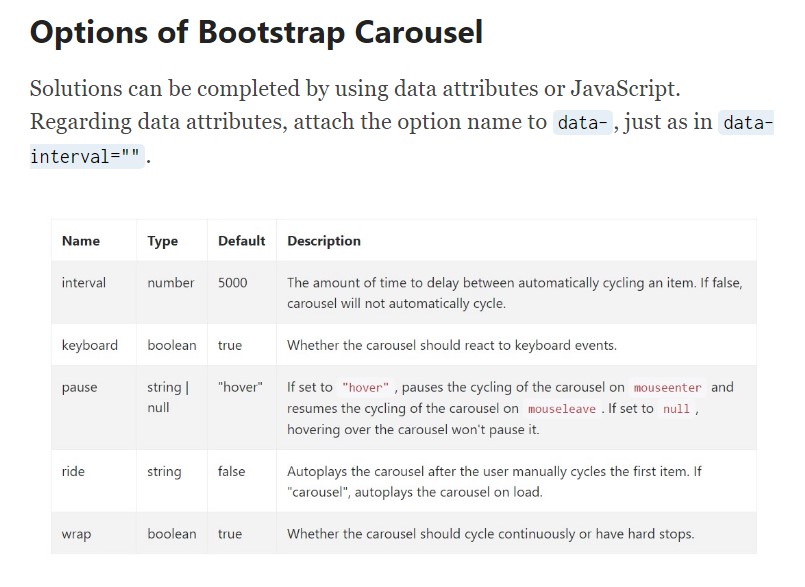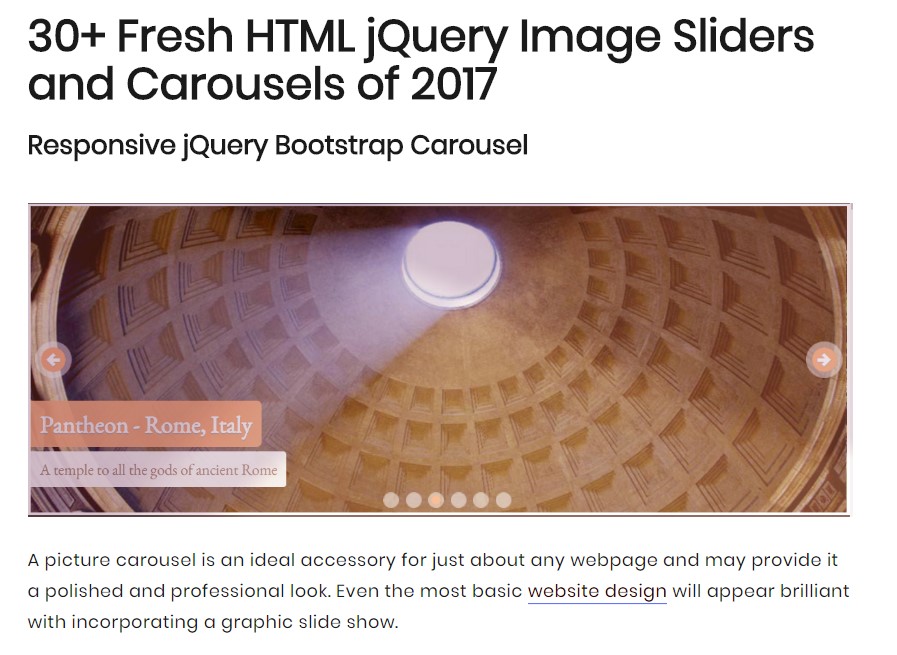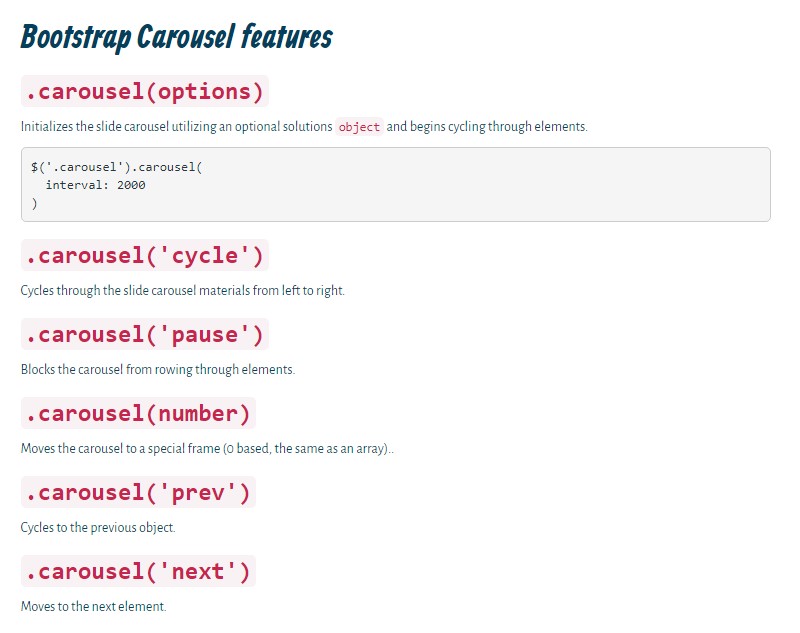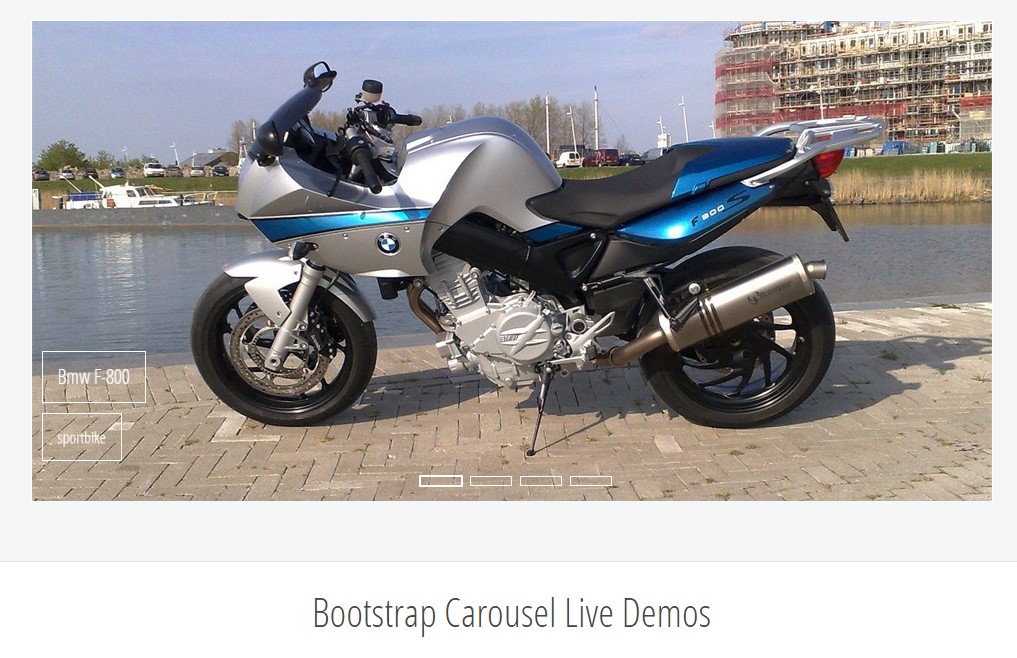Bootstrap Carousel Image
Introduction
Who exactly doesn't love flowing pics with various cool underlines and text identifying the things they represent, better relaying the text message or why not really much better-- additionally featuring a couple of switches around calling up the visitor to take some action at the very start of the web page since all of these are typically localised in the start. This has been really handled in the Bootstrap framework through the constructed in carousel feature which is perfectly supported and quite easy to receive as well as a clean and plain construction.
The Bootstrap Carousel Example is a slide show for cycling over a set of information, established with CSS 3D transforms and a some JavaScript. It works with a series of images, message, or custom made markup. It usually includes assistance for previous/next controls and indications.
Ways to employ the Bootstrap Carousel Image:
All you need to have is a wrapper element along with an ID to have the whole carousel component holding the .carousel and additionally-- .slide classes ( in the case that the second one is omitted the images will just transform without having the good sliding transformation) and a data-ride="carousel" property in case you really want the slide show to automatically begin at webpage load. There really should as well be one other component inside it carrying the carousel-inner class to incorporate the slides and as a final point-- wrap the images right into a .carousel-inner element.
For example
Slide carousels don't automatically normalize slide sizes. Because of this, you may possibly will need to apply added tools or else custom varieties to appropriately scale material. Although carousels support previous/next directions and indicators, they are certainly not explicitly required. Provide and custom considering that you see fit.
Don't forget to set a unique id on the .carousel for optional commands, most especially in case that you are really employing several slide carousels on a single web page.
Single slides
Here is a Bootstrap Carousel Mobile with slides only . Bear in mind the existence of the .d-block and .img-fluid on slide carousel pics to prevent web browser default pic placement.

<div id="carouselExampleSlidesOnly" class="carousel slide" data-ride="carousel">
<div class="carousel-inner" role="listbox">
<div class="carousel-item active">
<div class="img"><img class="d-block img-fluid" src="..." alt="First slide"></div>
</div>
<div class="carousel-item">
<div class="img"><img class="d-block img-fluid" src="..." alt="Second slide"></div>
</div>
<div class="carousel-item">
<div class="img"><img class="d-block img-fluid" src="..." alt="Third slide"></div>
</div>
</div>
</div>What's more?
You may additionally establish the time each slide gets presented on web page with including a data-interval=" ~ number in milliseconds ~" property to the main . carousel wrapper in the event you wish your illustrations being watched for a different period rather than the predefined by default 5 secs (5000 milliseconds) period oftime.
Slideshow using controls
The site navigation between the slides gets performed via identifying two hyperlink components along with the class .carousel-control together with an extra .left together with .right classes in order to pace them properly. As mark of these needs to be set the ID of the main slide carousel element itself and also several properties like role=" button" and data-slide="prev" or next.
This so far comes to assure the directions will get the job done effectively but to also make sure the site visitor understands these are certainly there and realizes exactly what they are doing. It also is a really good idea to insert a couple of <span> elements within them-- one having the .icon-prev plus one particular-- having .icon-next class as well as a .sr-only telling the display readers which one is prior and which one-- following.
Now for the necessary part-- setting the certain images that ought to go on within the slider. Each and every illustration element ought to be wrapped inside a .carousel-item which is a brand-new class for Bootstrap 4 Framework-- the previous version used to utilize the .item class which wasn't so much intuitive-- we presume that is actually why now it's replaced .
Putting in the previous and next controls:

<div id="carouselExampleControls" class="carousel slide" data-ride="carousel">
<div class="carousel-inner" role="listbox">
<div class="carousel-item active">
<div class="img"><img class="d-block img-fluid" src="..." alt="First slide"></div>
</div>
<div class="carousel-item">
<div class="img"><img class="d-block img-fluid" src="..." alt="Second slide"></div>
</div>
<div class="carousel-item">
<div class="img"><img class="d-block img-fluid" src="..." alt="Third slide"></div>
</div>
</div>
<a class="carousel-control-prev" href="#carouselExampleControls" role="button" data-slide="prev">
<span class="carousel-control-prev-icon" aria-hidden="true"></span>
<span class="sr-only">Previous</span>
</a>
<a class="carousel-control-next" href="#carouselExampleControls" role="button" data-slide="next">
<span class="carousel-control-next-icon" aria-hidden="true"></span>
<span class="sr-only">Next</span>
</a>
</div>Using indications
You have the ability to additionally incorporate the indications to the carousel, alongside the controls, too
In the main .carousel feature you might as well have an obtained listing for the carousel indications together with the class of .carousel-indicators along with certain list materials each coming with the data-target="#YourCarousel-ID" data-slide-to=" ~ correct slide number ~" properties on which the first slide number is 0.

<div id="carouselExampleIndicators" class="carousel slide" data-ride="carousel">
<ol class="carousel-indicators">
<li data-target="#carouselExampleIndicators" data-slide-to="0" class="active"></li>
<li data-target="#carouselExampleIndicators" data-slide-to="1"></li>
<li data-target="#carouselExampleIndicators" data-slide-to="2"></li>
</ol>
<div class="carousel-inner" role="listbox">
<div class="carousel-item active">
<div class="img"><img class="d-block img-fluid" src="..." alt="First slide"></div>
</div>
<div class="carousel-item">
<div class="img"><img class="d-block img-fluid" src="..." alt="Second slide"></div>
</div>
<div class="carousel-item">
<div class="img"><img class="d-block img-fluid" src="..." alt="Third slide"></div>
</div>
</div>
<a class="carousel-control-prev" href="#carouselExampleIndicators" role="button" data-slide="prev">
<span class="carousel-control-prev-icon" aria-hidden="true"></span>
<span class="sr-only">Previous</span>
</a>
<a class="carousel-control-next" href="#carouselExampleIndicators" role="button" data-slide="next">
<span class="carousel-control-next-icon" aria-hidden="true"></span>
<span class="sr-only">Next</span>
</a>
</div>Put in various underlines too.
Include underlines to your slides effectively with the .carousel-caption element within any .carousel-item.
If you want to bring in various underlines, information as well as keys to the slide provide an added .carousel-caption feature alongside the picture and put all the material you desire right inside it-- it will fantastically slide in addition to the illustration itself.
They may be simply concealed on smaller sized viewports, just as shown below, having optional display utilities. We hide them primarily using .d-none and provide them back on medium-sized tools through .d-md-block.

<div class="carousel-item">
<div class="img"><img src="..." alt="..."></div>
<div class="carousel-caption d-none d-md-block">
<h3>...</h3>
<p>...</p>
</div>
</div>Extra secrets
A cute method is when ever you wish a hyperlink or even a tab in your web page to guide you to the carousel but additionally a certain slide inside it for being visible at the time. You have the ability to actually accomplish this with delegating onclick=" $(' #YourCarousel-ID'). carousel( ~ the desired slide number );" property to it. Simply be sure you have definitely considered the slides numeration actually beginning with 0.
Handling
By using data attributes
Make use of data attributes to conveniently direct the location of the carousel .data-slide recognizes the keywords prev or next, which alters the slide placement about its own present location. Additionally, employ data-slide-to to pass on a raw slide index to the carousel data-slide-to="2", which in turn moves the slide location to a certain index beginning with 0.
The data-ride="carousel" attribute is put to use to signify a carousel as animating starting with page load. It can not really be applied in combo with ( redundant and unnecessary ) specific JavaScript initialization of the exact same carousel.
By using JavaScript
Call carousel manually having:
$('.carousel').carousel()Opportunities
Selections can be passed by means of data attributes or JavaScript. Regarding data attributes, attach the option title to data-, just as in data-interval="".

Approaches
.carousel(options)
Initializes the slide carousel having an optional alternatives object and begins cycling through items.
$('.carousel').carousel(
interval: 2000
).carousel('cycle')
Cycles through the slide carousel elements coming from left to right.
.carousel('pause')
Stops the carousel from cycling through objects.
.carousel(number)
Cycles the carousel to a certain frame (0 based, much like an array)..
.carousel('prev')
Cycles to the previous item.
.carousel('next')
Moves to the next item.
Occasions
Bootstrap's slide carousel class exhibits two activities for hooking in to slide carousel functionality. Both activities have the following extra properties:
- direction: The direction where the carousel is moving (either "left" as well as "right").
- relatedTarget: The DOM element that is being really slid in to place just as the active element.
Every one of slide carousel events are ejected at the slide carousel itself ( such as at the <div class="carousel">).

$('#myCarousel').on('slide.bs.carousel', function ()
// do something…
)Final thoughts
So actually this is the solution the slide carousel component is structured in the Bootstrap 4 framework. It is definitely really easy as well as uncomplicated . However it is quite an eye-catching and useful technique of feature a a lot of material in a lot less space the carousel element should however be employed very carefully considering the clarity of { the information and the website visitor's comfort.
An excessive amount of illustrations could be skipped to get seen with scrolling down the page and in the event that they slide way too quick it might end up being very difficult certainly seeing them or else review the messages which in turn might just in time confuse or else annoy the website visitors or perhaps an significant appeal to activity could be missed out-- we definitely really don't want this particular to develop.
Examine a number of video clip short training relating to Bootstrap Carousel:
Related topics:
Bootstrap Carousel approved information

Bootstrap 4 Сarousel issue









